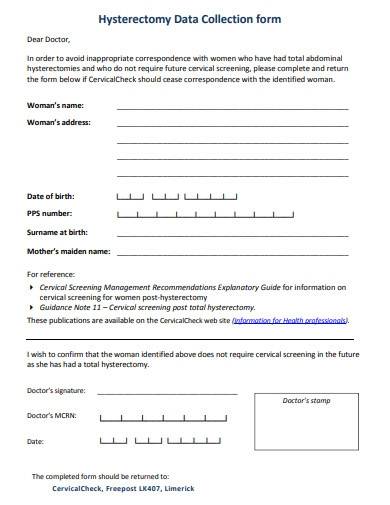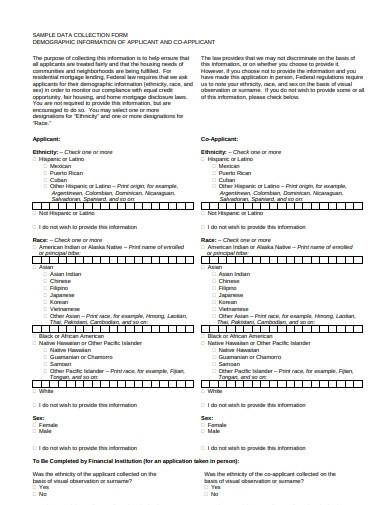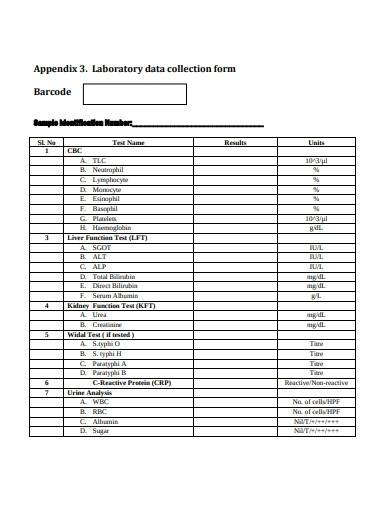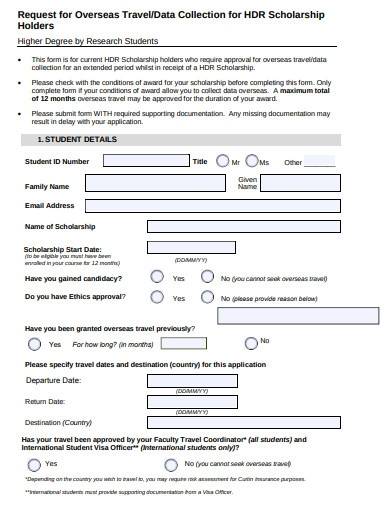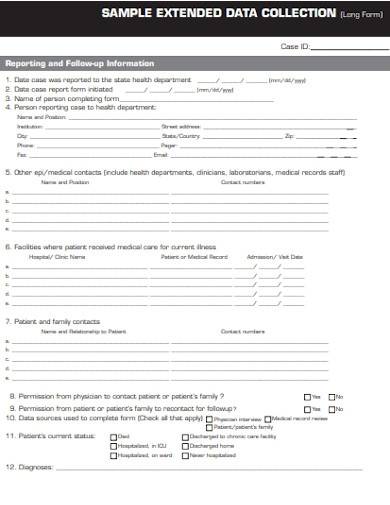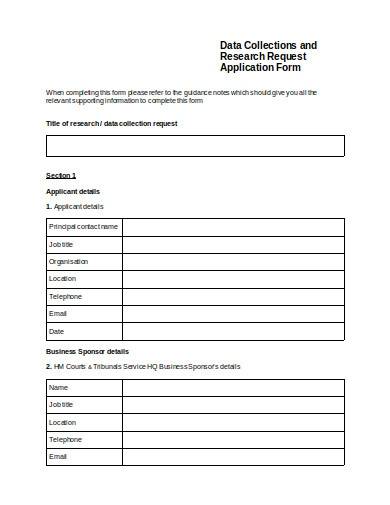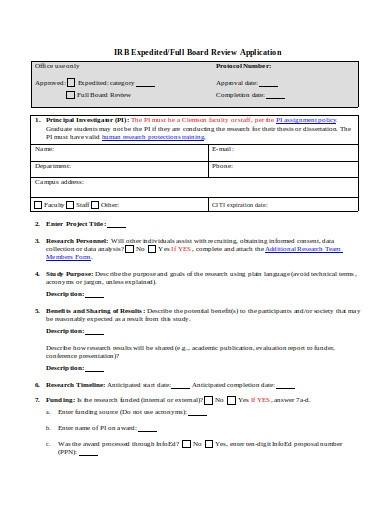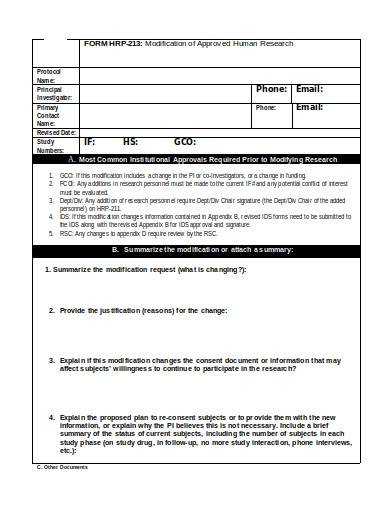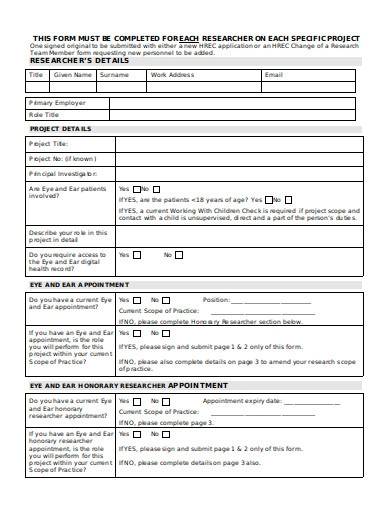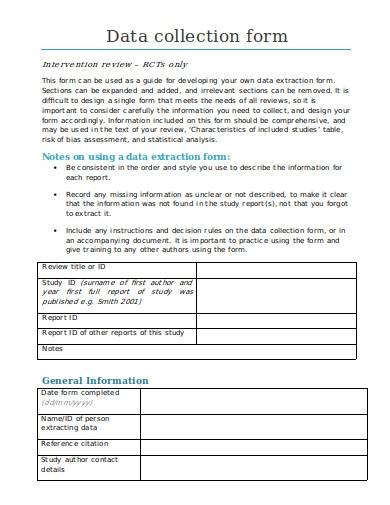Data collection is the process of gathering information. The information gathered during data collection largely depends on where it is used. In research, collecting data is an important step. Researchers use data to study a subject, problem, issue or a phenomenon. Without available data, researches won’t be able to go anywhere with their work. The use of research data collection forms is a convenient way of gathering data for specific research projects. Researchers always have this kind of form whether they are studying an existing project or starting a new one. Some research data collection samples and templates are provided below for your reference.
FREE 10+ Research Data Collection Form Samples & Templates
1. Hysterectomy Data Collection Form
2. Standard Data Collection Form
3. Sample Data Collection Form
4. Laboratory Data Collection Form
5. Overseas Travel Data Collection Form
6. Sample Extended Data Collection Form
7. Data Collections and Research Form
8. Format of Research Application Form
9. Human Research Data Collection Form
10. Research Project Detail Form
11. Data Collection Form Template
What Is a Research Data Collection Form?
A research data collection form is a convenient tool used in the systematic gathering of information about a specific research topic. It outlines the basic information that is necessary for the research project. Different information is gathered for research in different fields. In industrial or business research, the data mainly gathered is on the project’s information. During medical or clinical trials, the data gathered includes the subject’s general informational an informed consent. More information is gathered from hospital patients through patient monitoring and evaluation.
Researchers use a data collection form in conjunction with any of the data collection techniques. The four techniques are observation, the use of questionnaires, conducting interviews, and having focused group sessions. All four data collection techniques can be used all together in one research project, which allows the researcher to gather more efficient and reliable information. Data that is recorded in the form is then used as a reference in writing the research methodology section and in the presentation of the research report.
How To Create a Research Data Collection Form
If you’re making a research data collection form, aim for a simple form. What is important in this kind of form is its contents and how efficiently you can gather data using it. To make a reliable research data collection form, you will need to heed the following best practices.
1. Use Data Collection Techniques
Provide a space dedicated to each of the data collection techniques. This way, you can easily record data according to the method you used for collection. It makes data comparison easy to do. A space large enough to record data clearly and neatly is also ideal so that you won’t have the information mixed up. Mixed up information will most likely turn out useless.
2. Don’t Settle for a Single Type of Form
There are other options for making forms aside from the paper type, so don’t settle for that type alone. You can utilize technology and make digital forms. It will help you gather data quickly and conveniently. You can also reach a lot of audiences or participants if you use alternative ways of gathering data.
3. Add Special or Specific Instructions
If a certain step needs to be done using a specific set of steps or if there are special instructions that you want to be done, make sure to add it in the form. You can only get the exact type of information that you want if you give out clear and specific instructions.
4. Collect Only What You Need
Another way to effectively avoid mixing up data is by collecting only the information that you need as you go. Gathering data one scenario at a time helps you focus on the problem you are currently facing and increases your chances of getting the correct answer is a shorter period. If you do things one at a time, you’ll get better results.
5. Test Your Form
How do you know if your data gathering form works? You simply put it to the test. Use it in an actual research project that you are doing or have a fellow researcher help you test it. Get their feedback and advice, and revise your form according to what you think is useful.
FAQs
What is the best type of data collection technique?
Each of the four data collection technique has its advantages and disadvantages. Also, there’s no one best data collection technique for al types of research projects. Each technique is important and provides essential information depending on the type of research project conducted. For example, using questionnaires to gather responses from a specific group of people is the most effective technique for a research study that involves a large population. A focus group session is also more effective if a group of experts needs to collect and analyze data at the same time.
What are the consequences of improperly collected data?
Gathering the wrong information is easier because it is available everywhere. If you’re not careful, you might just end up using the wrong information in your study. The consequences are you won’t be able to answer research questions accurately, you will be unable to validate the study or even conduct a repeat, and you’ll have wasted resources. As if that’s not bad enough, you’ll be misleading other researchers and compromise decision-making for public policies. It will all result in harming both human participants and animal subjects.
Research data collection forms help in preserving data integrity and detect errors in the data collection process. It is undoubtedly a useful tool that every researcher must use. Get hold of research data collection form samples and templates by simply downloading any of the samples provided above. Check them out now!
Related Posts
FREE 8+ Printable Survey Forms in PDF MS Word
FREE 7+ Sample Health Survey Templates in PDF
FREE 16+ Activity Evaluation Form Samples & Templates in PDF
FREE 9+ Research Log Samples & Templates in PDF MS Word
FREE 8+ Sample Research Consent Forms in PDF MS Word
FREE 18+ Sample Forms in PDF
FREE 9+ Sample Delivery Order Forms in MS Word PDF
FREE Sample Survey Reports in PDF MS Word
9+ Sample Quantitative Analysis
FREE 40+ Agreement Forms in PDF MS Word
FREE 6+ Sample Survey Consent Forms in PDF MS Word
FREE 60+ Application Forms in PDF
FREE 10+ Research Analyst Job Description Samples in MS Word,DF
FREE 9+ Sample Interview Consent Forms in MS Word PDF
FREE 9+ Sample Informed Consent Forms in PDF MS Word

